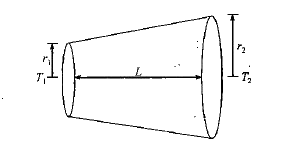Find the heat current through the frustum of a cone shown in figure-4.20. Temperature of its two ends are maintained at T1 and T2(T_(2)>T_(1)) respectively and the thermal conductivity of the material is k.

Here r=r1+(r2−r1L)x
As shown in figure we consider an elemental disc at a distance x from left face. Then thermal resistance ofthis elemental disc is given as
dRth=1k.dxπ(r1+r2−r1Lx)2
Total thermal resistance offrustum is
Rth=∫dRth=1kπ∫10dx(r1+r2−r1L.x)2
=Lkπ(r2−r1)⎡⎢
⎢⎣1(r1+r2−r1L.x)⎤⎥
⎥⎦l0
=Lkπ(r2−r1)[1r1−1r2]
=Lkπ1r2
Thus heat current through frustum is
dQdt=T2−T1Rth=kπ1r2(T2−T1)L
Topper's Solved these Questions
- HEAT TRANSFER Book:PHYSICS GALAXY - ASHISH ARORAChapter:HEAT TRANSFER Exercise:Practice Exercise 4.2
Explore 8 Videos
- HEAT TRANSFER Book:PHYSICS GALAXY - ASHISH ARORAChapter:HEAT TRANSFER Exercise:Practice Exercise 4.3
Explore 5 Videos
- HEAT TRANSFER Book:PHYSICS GALAXY - ASHISH ARORAChapter:HEAT TRANSFER Exercise:Illustrative Example 4.29
Explore 1 Video
- HEAT AND THERMAL EXPANSIONBook:PHYSICS GALAXY - ASHISH ARORAChapter:HEAT AND THERMAL EXPANSIONExercise:UNSOLVED NUMRICAL PROBLEMS FOR PREPARATION OF NSEP, INPhO & IPhO
Explore 82 Videos
- Kinetic Theory of Gases and Gas LawsBook:PHYSICS GALAXY - ASHISH ARORAChapter:Kinetic Theory of Gases and Gas LawsExercise:Unsolved Numerical Problems for Preparation of NSEP, INPhO & IPhO
Explore 64 Videos
Similar Questions
A hollow tube has a length l, inner radius R1 and outer radius R2 . The material has a thermal conductivity K. Find the heat flowing through the walls of the tube if (a) the flat ends are maintained at temperature T1 and T2(T_(2)gtT_(1)(b)the∈softhetubeisma∫a∈edattemperatureT_(1)andtheoutsisma∫a∈edatT_(2) .
View SolutionA thick cylindrical shell made of material of thermal conductivity k has inner and outer radii r and R respectively and its length is L. When the curved surface of the cylinder are lagged (i.e., given insulation cover) and one end is maintained at temperature T1 and the other end is maintained at T2(<T1), the heat current along the length of the cylinder is H. In another experiment the two ends are lagged and the inner wall and outer wall are maintained at T1 and T2 respectively. Find the radial heat flow in this case.

View Solution
Knowledge Check
Two identical vessels are filled with equal amounts of ice. The vessels are made from different materials. If the ice melts in the two vessels in times t1 and t2 respectively, then their thermal conductivities are in the ratio:
At1t2Bt2t1Ct22:t21Dt21:t22Two identical vessels are filled with equal amounts of ice. The vessels are made from different materials. If the ice melts in the two vessels in times t1andt2 respectively, then their thermal conductivities are in the ratio
At1t2Bt2t1Ct22:t21Dt21:t22
Consider two rods of equal cross - sectionai area A, one of Aluminium and other of iron joined end to end as shown in figure -4.8. Length of the two rods and their thermal coductivities are l1,k1and l2,k2 respectively . If the ends of the rods are maintained at temperature T1 and T2,(T1>T2) find the temperature of the junction in steady state .

View SolutionA composite cylinder is made of two materials having thermal conductivities K1 and K2 as shown. Temperature of the two flat faces of cylinder are maintained at T1 and T2. For what ratio K1/K2 the heat current throught the two materials will be same. Assume steady state and the rod is lagged (insulated from the curved surface).

View SolutionA slab of cunductivity k is in the shape of trapezoid as shown I figure. If the two end faces be maintained at temperature T1=50∘CandT2=25∘C, then determine the thermal current through the slab by ignoring any heat loss through the lateral surfaces.
 .
.
View SolutionIn the frame shown in figure made up of metallic rods of identical size, the ends A and F are maintained at T1 and T2 respectively. The rate of heat flow from A to C is ω. If C and D are instead maintained at T1 & T2 respectively find, find the total rate of heat flow.

View SolutionThree rods of same cross-section but different length and conductivity are joined in series . If the temperature of the two extreme ends are T1andT2(T1>T2) find the rate of heat transfer H.

View SolutionTwo conducting cylinders of equal length but different radii are connected in series between two heat baths kept at temperatures T1=300KandT2=100K, as shown in the figure. The radius of the bigger cylinder is twice that of the smaller one and the thermal conductivities of the materials of the smaller and the larger cylinders are K1andK2 respectively. If the temperature at the junction of the two cylinders in the steady state is 200 K, then K1/K2=__________.
(##JA_18_PHY_P1_E02_008_Q01.png" width="80%">
View Solution

